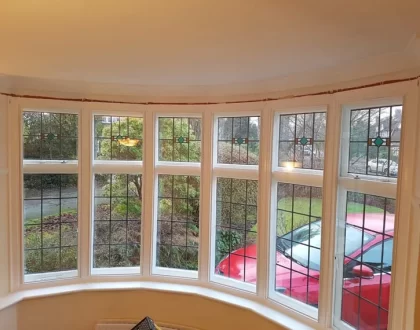How can I stop condensation?

Why is there condensation on my windows?
Waking up to cold wet windows can really dampen your mood. When cold surfaces meet humid air it makes water droplets form. Over the colder months this problem becomes more noticeable as your heating gets switched on and dramatically increases the temperature difference between indoor and outdoors.
Believe it or not, we are all unwitting contributors to indoor condensation. Just by breathing, each of us adds about 60-70 ml of water to the air every hour. If you have a gas cooker, burning 1 cubic foot of gas releases an equal amount of water into the air. Plus if you dry your laundry indoors without opening your windows, the moisture level increases even further.
It is normal and healthy to have between 30-50% humidity in your home, but too much can cause mould and asthma symptoms and too little can cause dry skin and respiratory problems. Thankfully we have some solutions to your condensation conundrum.
What causes condensation?
The condition of our primary windows plays a crucial role in this drama. Ill-fitting windows allow cold air to circulate between the panes, setting the stage for condensation. Moreover, deteriorating glazing putty can let in rainwater, which then gets drawn inside by capillary action (this means liquid flowing through narrow spaces without the assistance of gravity), further increasing indoor humidity.
Additionally, the construction of the building itself, such as masonry in poor condition or rotten/damaged window frames, can contribute to the problem. External factors like vegetation, climbing plants, and faulty gutters also contribute to indoor moisture levels.
Many older buildings lack damp proof courses, leading to moisture issues. Apart from the primary causes of condensation, secondary factors come into play. For example, as initial moisture evaporates, it leaves behind salt crystals. While most of these salts eventually cause no harm, some, like chlorides and nitrates, continue to absorb moisture from the air.
Does Secondary Glazing help?
A common misconception is that secondary glazing causes condensation. However, building experts largely disagree with this notion. Our team at Clearview has delved deep into the condensation conundrum, guided by insights from the Ministry of Public Building and Works. Secondary glazing doesn’t create condensation where none existed before.
One of the great benefits of secondary glazing is that it significantly improves your thermal efficiency. This can in turn help by reducing the most visible elements of condensation. It’s a complex issue, and while secondary glazing often helps reduce or eliminate condensation, there are times when the exact cause of excess humidity remains elusive.
How can I deal with condensation?
In our quest to seal our homes against harsh weather, we’ve inadvertently trapped moisture inside. The key to managing condensation lies in balancing a building’s humidity, heating, and ventilation. This balance shifts with the seasons, and a bit of experimentation can go a long way in finding the right levels for your home. Here are our top tips:
- Tumble dryers, not radiators: Drying laundry on radiators may seem convenient, but it adds a considerable amount of moisture to your home. Instead, using a tumble dryer can help keep this moisture in check. While it’s true that we can’t reduce all sources of moisture (like breathing or bathing), controlling where we can is a step in the right direction.
- Install a dehumidifier: Investing in a dehumidifier can be a game-changer. Not only does it actively remove moisture from the air, but it’s cost-effective in the long run. Dehumidifiers come in various sizes and capacities, so you can find one that suits your specific needs.
- Improve ventilation: Regularly opening windows to exchange warm, moist air for cooler, dry air can significantly reduce indoor humidity. However, this might lower the indoor temperature, so finding a balance that works for everyone in the house is key.
- Isolate moisture: Keeping bathroom and kitchen doors closed and focusing on ventilating these rooms can prevent moisture from spreading throughout the house. This localised approach to ventilation can be more manageable and less disruptive.
- Maintain ambient temperature: Maintaining a consistent, moderate temperature in your home can be more effective than fluctuating between warm and cold. This approach helps the air retain moisture, reducing the amount that condenses on cold surfaces.
Conclusion
A combination of the above suggestions will provide you with effective results. Visibly, secondary glazing should have a marked improvement on your condensation issues, while also significantly improving thermal efficiency and reducing noise.
Consider your habits around the home and see what you can do to reduce the moisture in the air. Obviously we don’t suggest reducing your breathing, but definitely think about how your habits contribute to the moisture of the air and see what you can do to improve your living space! Get a free quote for your secondary glazing options today.
Recommended Posts

Condensation Risk Analysis Systems
15/08/2025


